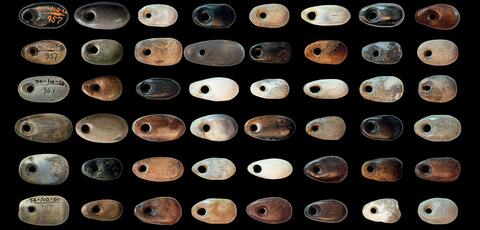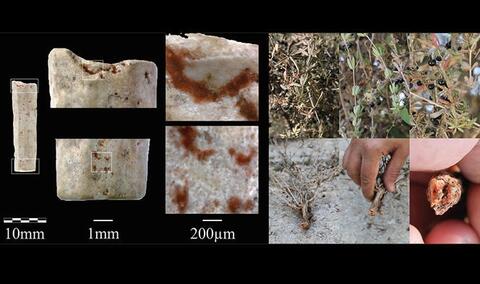
How humans stole the color red from plants
Between 13,000 and 9,650 years ago, the Natoufian culture developed on the eastern Mediterranean coast of northern Israel. According to recent discoveries, these hunter-gatherers were the first to use red pigments of organic origin.
"It was a great surprise to discover such ancient and well-preserved pigments of organic origin", confides Laurent Davin, archaeologist at the Laboratoire Technologie et ethnologie des mondes préhistoriques (Temps)1 and the Hebrew University of Jerusalem, and co-author of the study just published in the journal PLOS ONE. Dated to around 15,000 years before the present day, these non-mineral dyes were found on beads and ornaments from the Kebara cave (Mount Carmel, Israel), preserved for almost a hundred years at the Rockefeller Museum in Jerusalem. These Natoufian artefacts were known to all, but as they had never been studied, specialists had always believed that the red they perceived on the shells, teeth and other bones of the ornaments had a mineral origin. In this case, ochre. Ochre is the "king" of mineral dyes, "having been used for at least 300,000 years by various hominin species. The recurrent, daily use of ochre by our species began around 140,000 years ago in Africa", explains Laurent Davin.
Symbolism of an intense red
The discovery required the use of cutting-edge analytical technologies such as scanning electron microscopy and Raman spectrometry, carried out by Ludovic Bellot-Gurlet, from the Monaris2 laboratory, and Julien Navas, from the Conservatoire national des arts et métiers. These analyses enabled the researchers to understand from the outset that they were dealing with organic rather than mineral dyes. "The high presence of carbon and oxygen left little doubt as to the organic origin of the red pigments. Raman spectrometry helped us to determine what type of organism these pigments came from", explains Laurent Davin. In this case, the Natoufian red came from typical Mediterranean plants of the Rubiaceae family, such as madder.

Perle de coquillage vieille de 15 000 ans du Natoufien ancien de la Grotte de Kebara avec des résidus de colorant rouge organique fabriqué à partir de racines de Rubiacées comme la Garance (à droite). © Laurent Davin/CC BY
“Natoufian red" was not easy to obtain. "First of all, you had to dig down, grab the roots, dry them and grind them into a powder, which was then boiled. Then it had to macerate for several days, depending on the desired shade", says the archaeologist. A long and complex process, compared to the transformation of ochre, which simply requires scraping or grinding the stone to obtain its color. In addition to the time needed to produce it, this organic pigment requires a thorough knowledge of the environment and, above all, the development of specific technologies for its extraction. "This also means that we had to go through a lot of experimentation to achieve this result," said Laurent Davin.
But why did the Natufians develop organic pigments that were so complicated to obtain, when they had ochre in abundance at their fingertips? For Laurent Davin, this is "the fundamental question" inherent in his discovery. To answer it, the archaeologist believes that the use of pigments, and ochre in particular, must be placed in its prehistoric context. At that time, ochre had two possible uses: either in domestic tasks such as degreasing animal hides to make leather, or for symbolic purposes to color homes, bodies or objects. "Even today, we don't really know what symbol red is associated with," he says.

Les seize perles en coquillage, dent et os du Natoufien ancien de la Grotte de Kebara analysées dans le cadre de cette étude. Les perles 1-10 sont toutes des perles en coquillage colorées avec le colorant organique rouge des Rubiacées et les perles 11-16
According to the archaeologist, "the answer may lie in the intensity of the organic red compared with the mineral ochre. It may have been a way for the Natoufians to show that their finery was redder than that of other human groups living in the region". In addition to the intense red of their finery, the Natoufians also displayed a certain refinement, as well as subtle details for those who understood their significance. For example, the shells used in the ornaments were not always the same shade, nor the same shape, "some were cut out, others were in different positions from the rest of the ornament, for example", illustrates the researcher.
The beginnings of sedentary life
Aside from the organic pigments themselves, this discovery provides a wealth of information about both the people who used them and their culture. Indeed, why develop such a time-consuming extraction process, from which no one could derive any source of energy? The explanation is simple: the Natoufians were sedentary hunter-gatherers. "They are clearly among the world's first sedentary societies. In their territory, which stretches from southern Turkey to the Sinai, we find the remains of humanity's first villages," says Laurent Davin. The Natoufians therefore had time to devote to something other than the predatory activities of their ancestors.

Réplique expérimentale de perles en coquillages avec le colorant organique rouge Natoufien à base de racines de Rubiacées. ©Laurent Davin/CC BY
The upheaval in the social organization of Natoufian society was major. "We think it was this sedentary lifestyle that brought about a change in the transmission of identity, through ornaments for example, but also in the representation of individual and shared identities," points out Laurent Davin. The Natoufians are at the origin of what will fundamentally transform the life of our species. After all, once Homo sapiens had settled down, the processes that led to agriculture and then to animal husbandry, which are still used today in all human societies, began."
It's not just agriculture that has endured through the ages, the use of plant and animal dyes has also endured. From Phoenician purple, derived from the mollusc murex brandaris and used throughout the ancient Mediterranean, to the carmine red extracted from the cochineal (Kermes vermilio), found today in foodstuffs, to the madder red used in Tutankhamen's tomb, the Shroud of Turin, Van Gogh's paintings or to dye French army pants during the First World War, the Natoufians set a trend that is unlikely to fade anytime soon.
Référence
Davin, L., Bellot-Gurlet, L. et Navas, J., "Plant-based red colouration of shell beads 15,000 years ago in Kebara Cave, Mount Carmel (Israel)", PLOS ONE, 2023. DOI 10.1371/journal.pone.0292264
Notes
1 Unité CNRS/Université Panthéon-Sorbonne/Université Paris-Nanterre.
2 De la Molécule aux Nano-objets: Réactivité, Interactions et Spectroscopies. Unité CNRS/Sorbonne University
This article was translated from the Journal du CNRS and written by Mehdi Harmi.
